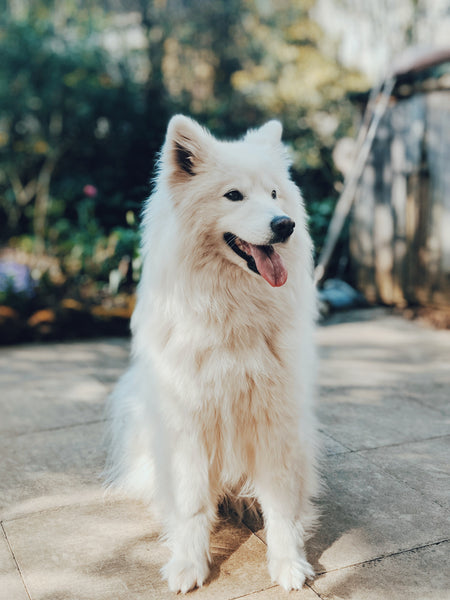Even though he can’t speak “human,” your dog is constantly using his posture, facial expressions, and body language to communicate with you. However, dog body language comes with a lot of nuance. For example, a wagging tail could either be a sign of happiness or a sign of aggression; a hunched-forward position could either be an invitation to play or a sign of submission and fear. It’s also important to understand the context of the situation and take every aspect of your dog’s body language into consideration in order to fully understand his mood.
As a pet owner, having an understanding of your dog’s body language will give you a better understanding of what he may be thinking or feeling. Read on for a basic overview of dog body language, keeping in mind that specifics may vary from dog to dog.

Eyes
As the saying goes, “the eyes are the window to the soul.” A glimpse into your pup’s eyes will give you a good idea of how he’s feeling overall. If he’s calm and happy, his eyes will appear soft and relaxed—sometimes like a squint.
A hard, cold stare, on the other hand, may be a sign that your dog is feeling angry or threatened. If he’s feeling protective, it’s best to respect his space and keep your distance.
If your dog is feeling scared, he may exhibit something called “whale eye.” This is when the whites of the eyes are very visible, with eyes appearing larger than usual.
As with humans, eye contact is important for dogs. If your pooch is avoiding eye contact, he may be expressing discomfort or trying to diffuse a situation by appearing more submissive.

Ears
From long and floppy to short and perky, dog ears clearly have their differences. While it may be easier to notice the subtleties in perky ears, it’s still possible to notice ear position changes in dogs with floppy ears—all you have to do is look at the base of the ear.
The ears of a relaxed pooch will generally be positioned to the back or sides. As he becomes more interested or aroused, his ears will perk up and point forward toward the object of interest (he may even do that endearing head tilt). If he’s feeling stressed or nervous, his ears may appear to be pinned down, or flat and pointing outward.
Take some time to observe your dog’s ears on a regular basis so that you have a good understanding of their regular position. That way, you’ll be able to better identify changes in his demeanor.

Mouth
Your dog may not smile or frown the way humans do, but his mouth can still tell you a lot about his mood.
If he’s relaxed, his mouth will typically be slightly open in a submissive grin. However, if he begins baring his teeth with a snarl or growl, take it as a warning that he needs his space or needs to be removed from a stressful situation.
While humans yawn when we’re tired or bored, dogs tend to yawn when they’re stressed. Lip licking is another sign of stress… or a sign that he just ate something yummy, which is a prime example of why we need to take posture, sounds, and other body language into consideration when trying to understand our dogs.

Tail
A wagging tail is typically associated with a happy, excited dog. However, there are a few different types of tail wags, and it’s important that we know the difference.
First, take some time to identify where your dog’s tail rests when it’s in a neutral position—this is crucial for understanding what type of tail wag he’s doing. Like ears, tails vary in shape and size, so keep in mind that some dogs may need to rely on other body language more heavily than their tails.
A neutral, slightly raised tail with a brisk wag is generally a sign of happiness. If the tail is lowered, he may be feeling scared or submissive. If the tail is raised (and even wagging), your dog may be feeling aggressive.
If your dog’s tail is perked up along with his ears, he may be showing that he’s curious and ready to explore.

Body/Posture
If your dog’s body seems loose and relaxed, then he’s likely feeling relaxed. Alternatively, if his body appears tight and tense, he’s probably feeling tense.
A relaxed, playful dog’s body movements will generally be loose and wiggly. If he’s leaning forward in a “bow” position, he may be inviting you to play. Similarly, a hunched over, cowering position can also be a sign of submission or fear—although this will also be accompanied by more tense body movements and different facial expressions.
Just as dogs typically try to appear small to avoid conflict, they also try to appear larger when they want to display dominant behavior, with head and tail raised.
If your dog’s body language is telling you that he’s feeling stressed or anxious, try some of our favorite remedies to help with anxiety. Our Calming Hemp Chews use a delicious blend of natural ingredients to soothe your dog’s stress and anxiety. For an extra soothing boost, try our Premium Hemp Calming Chews.
Sources:
https://www.akc.org/expert-advice/advice/how-to-read-dog-body-language/
https://www.aspcapro.org/resource/7-tips-canine-body-language
https://www.dailypaws.com/dogs-puppies/behavior/common-dog-behaviors/dog-body-language
https://moderndogmagazine.com/articles/how-read-your-dogs-body-language/415













